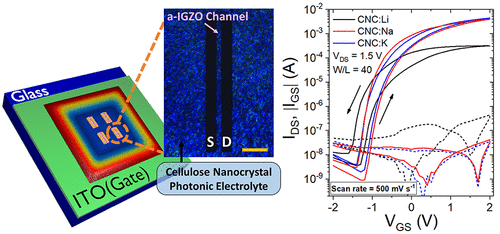当前位置:
X-MOL 学术
›
ACS Appl. Electron. Mater.
›
论文详情
Our official English website, www.x-mol.net, welcomes your feedback! (Note: you will need to create a separate account there.)
Ionically Modified Cellulose Nanocrystal Self-Assembled Films with a Mesoporous Twisted Superstructure: Polarizability and Application in Ion-Gated Transistors
ACS Applied Electronic Materials ( IF 4.7 ) Pub Date : 2019-12-03 , DOI: 10.1021/acsaelm.9b00652 Paul Grey 1, 2 , Susete N. Fernandes 1 , Diana Gaspar 1, 2 , Jonas Deuermeier 1, 2 , Rodrigo Martins 1, 2 , Elvira Fortunato 1, 2 , Maria H. Godinho 1 , Luis Pereira 1, 2
ACS Applied Electronic Materials ( IF 4.7 ) Pub Date : 2019-12-03 , DOI: 10.1021/acsaelm.9b00652 Paul Grey 1, 2 , Susete N. Fernandes 1 , Diana Gaspar 1, 2 , Jonas Deuermeier 1, 2 , Rodrigo Martins 1, 2 , Elvira Fortunato 1, 2 , Maria H. Godinho 1 , Luis Pereira 1, 2
Affiliation

|
Mesoporous structures made of cellulose nanocrystals (CNCs) and their self-assembly into films are of great interest not only due to their abundancy and sustainability but also due to their ease of chemical modification and nanoscale biomimicry capabilities. However, their implementation in (opto)electronic devices requires further understanding on how these self-assembled twisted mesoporous superstructures respond to electrical stimulus. In this regard, this work focuses on the infiltration of solid CNC droplets with three distinct alkali ions (Li+, Na+, and K+) to yield films with improved electrochemical response when compared to pristine ones, while preserving their photonic character. Electrochemical characterization shows capacitances of up to 2.5 μF cm–2 allowing for their integration as solid-state gate electrolytes in amorphous indium–gallium–zinc–oxide transistors, resulting in low operating voltages (<2 V), on/off ratios of up to 6 orders of magnitude, and high saturation mobilities >10 cm2 V–1 s–1. Devices fabricated on Na+ and K+ infiltrated CNC films present the best characteristics, indicating pure capacitive charging of the semiconductor. The insights presented here contribute to applications in solid-state ionics in mesoporous structures or the combination of optically active electrolytes capable of providing unique functionalities in ion-gated transistors and circuitry.
中文翻译:

具有介孔扭曲上层结构的离子改性纤维素纳米晶体自组装膜:极化率和在离子门控晶体管中的应用
由纤维素纳米晶体(CNC)制成的中孔结构及其自组装成膜的特性不仅引起人们的关注,不仅因为它们的丰度和可持续性,还因为其易于化学修饰和纳米级仿生能力。但是,它们在(光)电子设备中的实现需要进一步了解这些自组装的扭曲中孔上部结构如何响应电刺激。在这方面,这项工作着重于用三种不同的碱金属离子(Li +,Na +和K +)渗透固态CNC液滴,以产生与原始膜相比具有改善的电化学响应的膜,同时保留其光子特性。电化学表征显示电容高达2.5μFcm–2允许它们集成为非晶态铟镓锌氧化物晶体管中的固态栅电解质,从而导致低工作电压(<2 V),开/关比高达6个数量级以及高饱和迁移率> 10 cm 2 V –1 s –1。在渗透有Na +和K +的CNC膜上制造的器件具有最佳特性,表明半导体具有纯电容性。本文提供的见解有助于中孔结构中固态离子的应用,或能够在离子门控晶体管和电路中提供独特功能的光学活性电解质的组合。
更新日期:2020-01-06
中文翻译:

具有介孔扭曲上层结构的离子改性纤维素纳米晶体自组装膜:极化率和在离子门控晶体管中的应用
由纤维素纳米晶体(CNC)制成的中孔结构及其自组装成膜的特性不仅引起人们的关注,不仅因为它们的丰度和可持续性,还因为其易于化学修饰和纳米级仿生能力。但是,它们在(光)电子设备中的实现需要进一步了解这些自组装的扭曲中孔上部结构如何响应电刺激。在这方面,这项工作着重于用三种不同的碱金属离子(Li +,Na +和K +)渗透固态CNC液滴,以产生与原始膜相比具有改善的电化学响应的膜,同时保留其光子特性。电化学表征显示电容高达2.5μFcm–2允许它们集成为非晶态铟镓锌氧化物晶体管中的固态栅电解质,从而导致低工作电压(<2 V),开/关比高达6个数量级以及高饱和迁移率> 10 cm 2 V –1 s –1。在渗透有Na +和K +的CNC膜上制造的器件具有最佳特性,表明半导体具有纯电容性。本文提供的见解有助于中孔结构中固态离子的应用,或能够在离子门控晶体管和电路中提供独特功能的光学活性电解质的组合。



























 京公网安备 11010802027423号
京公网安备 11010802027423号